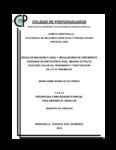Epoca de iniciación floral y reguladores de crecimiento exógenos en brotación floral, amarre de fruto, azúcares solubles, rendimiento y rentabilidad en litchi 'Brewster'
Abstract
Litchi (Litchi chinensis Sonn) es un frutal subtropical que presenta floración no uniforme y bajo amarre de fruto lo cual repercute en bajo rendimiento. El objetivo del presente trabajo fue determinar el momento de la iniciación floral mediante el estudio histológico del domo, estimular la brotación floral a partir de la aplicación de TDZ, BA, ethephon y KNO3, promover el amarre de fruto por medio de la aspersión única o repetida de 2,4,5 TP, TDZ, BA y AG3 y calcular la rentabilidad financiera con el empleo de reguladores de crecimiento en litchi cv. Brewster. La iniciación floral reconocida por el aplanamiento del domo ocurrió en el periodo entre noviembre y diciembre de 2007. En brotación floral la aplicación de TDZ (100 mg L-1) presentó mayor longitud del raquis (27 cm), número de panículas (28 panículas m-2), rendimiento (4,276 kg ha-1) y rentabilidad (VAN=443,805; B/C=8 y TIR=1; costos e ingresos actualizados a 10 años, i=18 %). Los azúcares evaluados no presentaron una tendencia clara por efecto de los tratamientos sin embargo hubo diferencias estadísticas entre los niveles de sacarosa, glucosa y fructosa entre hojas y yemas, tanto en luz como en sombra. Las yemas registraron el mayor contenido de azúcares solubles y estos fueron mayores en condición de luz. Los tratamientos aplicados para promover amarre de fruto no influyeron en la dinámica de crecimiento del mismo ni en su tamaño final. El tratamiento 2,4,5 TP (50 mg L-1) presentó mayor amarre de fruto en la primera semana posterior a la aplicación (~50 % retención) e incrementó el número de frutos a cosecha (6 frutos panícula-1). Azúcares solubles estuvieron en mayor concentración en panículas asperjadas con 2,4,5 TP (50 mg L-1) y AG3 (100 mg L-1). El uso de 2,4,5 TP elevó los costos de producción por lo cual AG3, aunque con menor producción (4 frutos panícula-1), fue el tratamiento con mayor rentabilidad (VAN=106,199; B/C=3.27 y TIR=1; costos e ingresos actualizados a 10 años, i=18 %). _______________ TIME OF FLORAL INITIATION AND EXOGENOUS GROWTH REGULATORS ON BUDBREAK, FRUIT RETENTION, SOLUBLE SUGARS, YIELD AND PROFITABILITY IN LITCHI ‘BREWSTER’. ABSTRACT: Litchi (Litchi chinensis Sonn) is a subtropical fruit tree with both erratic flowering and low fruit retention that cause low crop yield. The aims of this investigation were: to identify the floral initiation by using a domo histology study, to stimulate floral budbreak via applications of TDZ, BA, etephon and KNO3, to promote fruit retention by one or more application of 2, 4, 5 TP, TDZ, BA and AG3, and to calculate financial profitability of using growth regulators in litchi cv. ‘Brewster’. Floral initiation, when meristem had a dome-flattened shape, occurred between November and December 2007. At budbreak, TDZ (100 mg L-1) produced the largest raquis length (27 cm), number of panicles (28 panicles m-2), yield (4,276 kg ha-1) and profitability (VAN=443,805; B/C=8 y TIR=1; cost and profit updated for 10 years i=18%). There was not a clear effect of treatments on sugars content. However, statistical differences in the levels of sucrose, glucose and fructose were found between leaves and buds, either under light or shade conditions. Buds had the largest soluble sugars content under full light condition. Application of 2, 4, 5 TP (50 mg L-1) produced the highest fruit retention one week after application (~50 % retention) and increased fruit number at harvest. Also, this treatment and AG3 (100 mg L-1) increased the soluble sugars content in panicles. Although 2, 4, 5 TP produced better results, it increased the cost of production whereas application of AG3 (100 mg L-1) had the highest profitability (VAN=106,199; B/C=3.27 y TIR=1; costs and profit updated for 10 years, i=18 %), but produced lower yield (4 fruit panicle-1).
Collections
- Tesis MC, MT, MP y DC [138]

